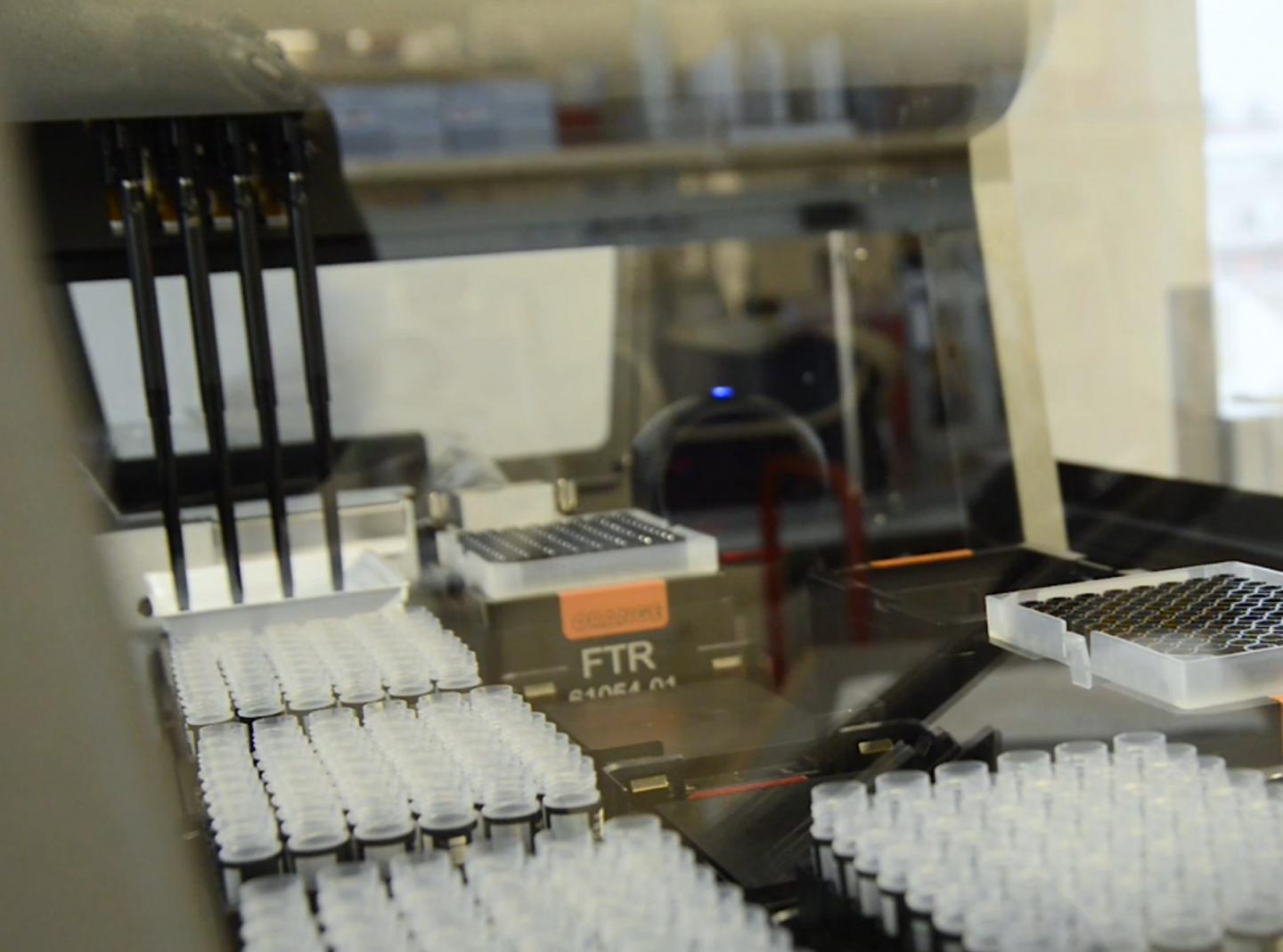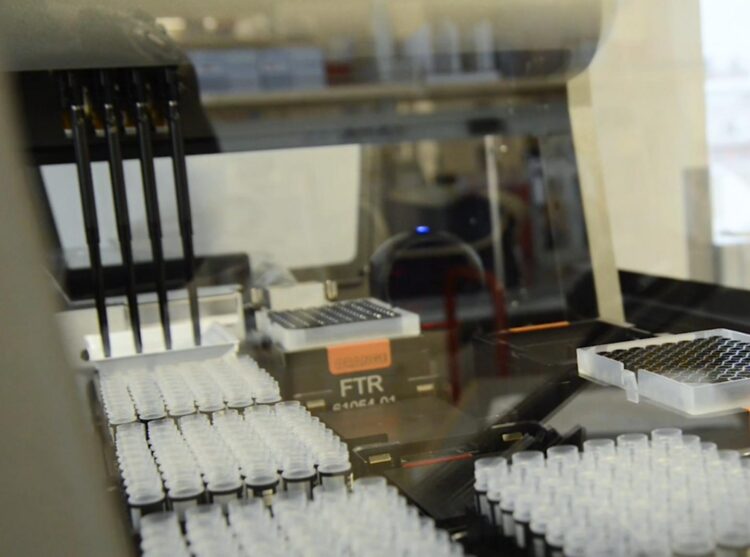Enhanced testing capability could help ensure sustained COVID-19 surveillance across the state of maryland after lifting of restrictions

Credit: University of Maryland School of Medicine
BALTIMORE, MD (April 10, 2020) – University of Maryland School of Medicine (UMSOM) Dean E. Albert Reece, MD, PhD, MBA, announced today the launch of a large-scale COVID-19 Testing Initiative that will significantly expand testing capability over the coming weeks, enabled by new funding of $2.5 million from the State of Maryland.
The new initiative will be launched with strong support and collaboration from the University of Maryland, Baltimore (UMB) and its President, Bruce Jarrell, MD, who has been supportive of the program since its inception. At the UMSOM, this initiative will be led by Claire Fraser, PhD, the Dean’s Endowed Professor and Director of the Institute for Genome Sciences (IGS) at UMSOM, and Sanford Stass, MD, Professor and Chair of both the UMSOM Department of Pathology and Department of Medical and Research Technology. This large-scale Testing Initiative will be progressively ramped up to eventually be able to run as many as 20,000 tests per day within the next few months. This will allow for far wider access to testing in Maryland through coordination with the City of Baltimore and the State Health Department.
“Our state is continuing to marshal every tool in the arsenal of public health to combat the spread of this virus, including the expertise of our university system,” said Maryland Governor Larry Hogan. “Increasing our testing capability is critical moving forward, and I want to thank the Institute for Genome Sciences and the Department of Pathology at the University of Maryland School of Medicine for partnering with us in an effort to significantly expand COVID-19 testing here in Maryland.”
The patient samples will be processed on robotic platforms with automated technologies housed in a laboratory in the UMSOM Institute for Genome Sciences (IGS). The new state funding would allow for the purchasing of additional platforms to facilitate an increase in testing capacity. Analysis of the samples will take place at the University of Maryland Pathology Associates (UMPA), CLIA/CAP accredited, which is operated by the UMSOM Department of Pathology.
“A major impediment we face is not understanding the extent of asymptomatic disease in the Maryland population,” said Dr. Jarrell. “Having broad access to high-throughput testing will show us where the disease is and how it’s spreading. That’s the guidance we need to control this pandemic more effectively until a vaccine can be developed.”
Added Dean Reece, who is also the Executive Vice President for Medical Affairs, University of Maryland, and the John Z. and Akiko K. Bowers Distinguished Professor.: “The state is in dire need of increased coronavirus testing, and the School of Medicine already has the early infrastructure in place, in terms of our technology and scientific expertise to help close the testing gap. This funding provided to us will enable us to better track the spread of the virus and provide swifter diagnoses and treatments to those in need.”
While 18 laboratory staff are currently needed to process a maximum 3,000 samples per day in the IGS facility, increasing to 20,000 samples per day would involve 60 laboratory personnel working three 8-hour shifts over a 24-hour period. This ramp up in staffing and sample testing will occur over a few months.
“Initially we will call in extra technicians who are currently working from home. Ramping up to a full staff will be done over time,” said Dr. Fraser. “I am sure many of our laboratory staff would be eager to return onsite to work for such a worthwhile endeavor.”
Most patients in the State have to wait for a week or more for commercial outfits to return their results due to a backlog of tests and limited capacity and throughput. The facility at UMSOM would be able to return the results to patients and doctors within 24 to 48 hours, dramatically increasing the turnaround time.
Analyzing test samples from patients suspected of having COVID-19 is a complex multi-step process that involves first transferring a portion of the sample to an inactivation solution and extracting its RNA, which contains the virus genetic code. The RNA is then converted to DNA and amplified using the CDC recommended assay. The laboratory at the UMSOM faculty practice site ultimately determines whether the patient’s sample contains the novel coronavirus. Automation of these steps is critical to increasing the laboratory ability to test thousands of samples per day.
“We have now implemented a reconfiguration of the IGS laboratory to establish this high-throughput testing capability,” said Jacques Ravel, PhD, Professor of Microbiology and Immunology and Associate Director of the Institute for Genome Sciences at UMSOM. “Working closely with the oversight of the Department of Pathology, the UMPA laboratory was able to obtain regulatory approval to enable us to process samples to be tested under the supervision of UMPA, a member of the UMSOM faculty practice.”
Dr. Ravel noted that Mike Humphrys, Director of the Microbiome Service Laboratory (MSL) at IGS, has led this effort, and his past-experience as a CDC laboratory scientist and expertise were key to this effort. The MSL, working with his laboratory team, repurposed and reprogrammed the robotic platforms to handle specific tasks related to COVID-19 testing, a task that they started in late February after it became clear that the virus was spreading beyond China. The machines had previously been used for research studies to characterize the bacteria that compose the human microbiome.
The testing facility at the University of Maryland Pathology Associates has been certified by the federal government to perform laboratory developed tests. These tests, referred to as LDTs, consist of a type of diagnostic test that is designed to be performed and used in a single laboratory, often located in a hospital. For COVID-19 testing, the UMSOM Department of Pathology plans to seek emergency use authorization from the FDA and then will submit submit data to the agency to verify the test’s performance both in detecting true positive results for the virus and true negative results that indicate the virus is not present.
“We already have the capability to perform testing in patients who are admitted to University of Maryland Medical Center to test for COVID-19,” said Dr. Stass. “This new funding initiative, however, will greatly improve our capabilities to reach deeper into the community and help provide expanded testing which is desperately needed to help bring the epidemic under control in the State of Maryland. The enhanced testing capability will also be leveraged in the longer term to ensure sustained COVID-19 surveillance across the State of Maryland.”
###
About the University of Maryland School of Medicine
Now in its third century, the University of Maryland School of Medicine was chartered in 1807 as the first public medical school in the United States. It continues today as one of the fastest growing, top-tier biomedical research enterprises in the world — with 45 academic departments, centers, institutes, and programs; and a faculty of more than 3,000 physicians, scientists, and allied health professionals, including members of the National Academy of Medicine and the National Academy of Sciences, and a distinguished two-time winner of the Albert E. Lasker Award in Medical Research. With an operating budget of more than $1.2 billion, the School of Medicine works closely in partnership with the University of Maryland Medical Center and Medical System to provide research-intensive, academic and clinically based care for nearly 2 million patients each year. The School of Medicine has more than $540 million in extramural funding, with most of its academic departments highly ranked among all medical schools in the nation in research funding. As one of the seven professional schools that make up the University of Maryland, Baltimore campus, the School of Medicine has a total population of nearly 9,000 faculty and staff, including 2,500 student trainees, residents, and fellows. The combined School of Medicine and Medical System (“University of Maryland Medicine”) has an annual budget of nearly $6 billion and an economic impact more than $15 billion on the state and local community. The School of Medicine faculty, which ranks as the 8th highest among public medical schools in research productivity, is an innovator in translational medicine, with 600 active patents and 24 start-up companies. The School of Medicine works locally, nationally, and globally, with research and treatment facilities in 36 countries around the world. Visit medschool.umaryland.edu
About the Institute for Genome Sciences
The Institute for Genome Sciences, founded in 2007, is an international research center within the University of Maryland School of Medicine. Comprised of an interdisciplinary, multidepartment team of investigators, the Institute uses the powerful tools of genomics and bioinformatics to understand genome function in health and disease, to study molecular and cellular networks in a variety of model systems, and to generate data and bioinformatics resources of value to the international scientific community. igs.umaryland.edu
Media Contact
Joanne Morrison
[email protected]
Original Source
https:/





